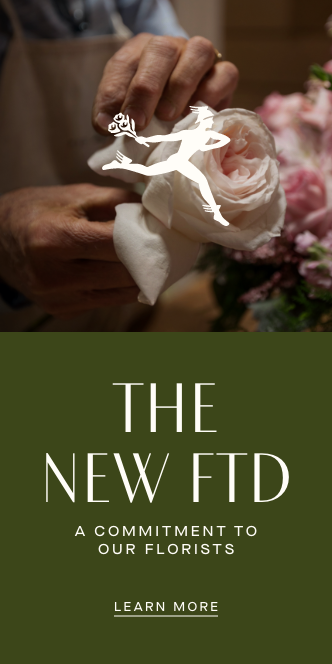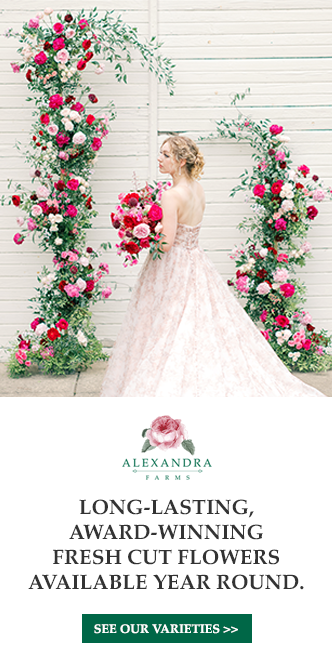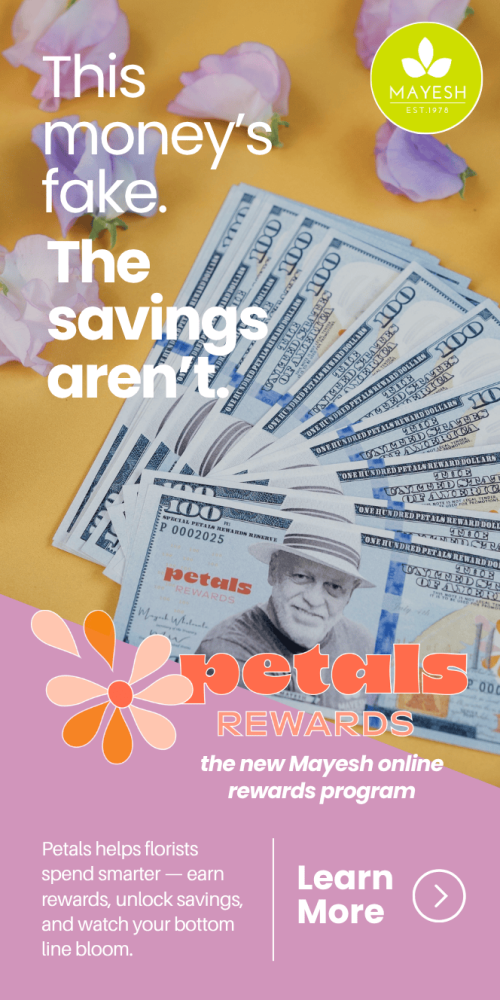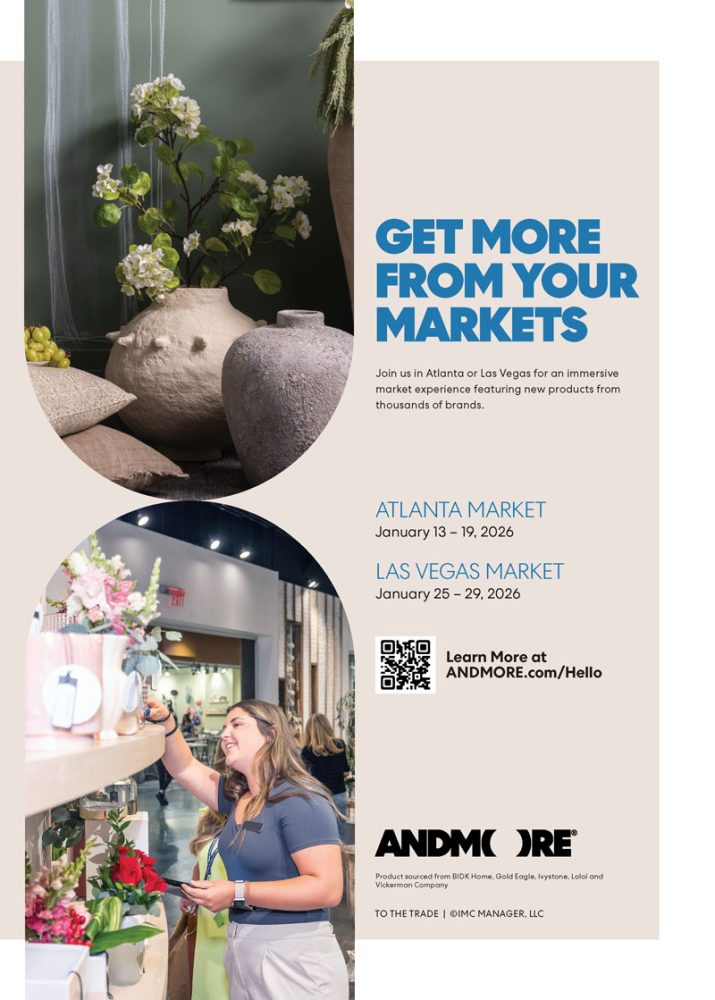
Danielle Dall’Armi,
owner of Rose Story Farm
in Carpinteria
From Field To Studio
Changing consumer attitudes and COVID’s disruption are redefining all channels of the floral marketplace.
By Debra Prinzing, PFCI
According to the just- published “2021 National Gardening Survey,” conducted by Garden Research, a division of The National Gardening Association (NGA), consumer awareness and behavior around cut flowers is significant. Four in 10 U.S. adults (41 percent, 104.6 million) reported spending some amount of money on cut flowers in 2020, with an average household expenditure of $62.63, or an estimated $6.55 billion spent by U.S. households last year.
Slow Flowers Society, the organization I founded in 2013, sponsored two additional survey questions, asking consumers to rate how important local and domestic flowers are to them. According to the NGA’s research director Paul Cohen, who conducted the omnibus survey of nearly 2,500 U.S. households, consumer preferences for local and domestic flowers is notable. In the survey, 57 percent of respondents noted that it is very important (33 percent) or somewhat important (24 percent) that the cut flowers they purchase are American grown.
Respondents feel similarly about the importance of cut flowers being grown locally, with 58 percent of respondents saying it is very important (29 percent) or somewhat important (29 percent).
Against this new U.S. consumer data, the conversations around “farm-to-florist” and farm-direct sourcing is more important than ever.

“If we teach our customers and clients about what is available locally, and if it’s important to them, perhaps we can shift our décor plans to envelop what’s local.
– Renee Tucci, AIFD, CFD, PFCI


Floral design by Renee Tucci,
AIFD, CFD, PFCI
For Renee Tucci, AIFD, CFD, PFCI, a Philadelphia, Pa.-based freelance florist and educator and president of the North East Regional Chapter of the American Institute of Floral Designers (AIFD), awareness of domestic flower sourcing began last year. “I noticed a big push in my area toward ‘local’ and to an eco-conscious way of doing business, as everyone is trying to support ‘small.’ A lot of AIFD members are like me, wondering how to get more involved with local flower farmers and how to support them.”
Tucci planned a “From Farm to Florist” webinar earlier this year, inviting AIFD members and others in the floral industry to attend. The presentation covered benefits and best practices to incorporate locally grown flowers into everyday designs and event work. Four flower farmers joined the discussion to share their sourcing advice for florists.
From anecdotal response, Tucci believes that a desire to source flowers locally will only increase. “If we teach our customers and clients about what is available locally, and if it’s important to them, perhaps we can shift our décor plans to envelop what’s local.”
She’s quick to note that this doesn’t mean abandoning allegiances to conventional floral wholesalers. “Some of the wholesalers I work with have savvy websites, and they list exactly what farms or regions their flowers are coming from, so we’re able to filter and buy local through our traditional outlets. I hope more wholesalers get in tune with that.”

During the past year, the floral community was hit with unprecedented challenges. Across all channels, growers and florists alike experienced increasing demand, yet the way flowers move through the supply chain changed, says Danielle Dall’Armi, owner of Rose Story Farm in Carpinteria, Calif., who has been growing garden roses for wedding and event florists for more than two decades. Because of COVID and the initial closure of traditional wholesale markets, “Farmers had to go direct to florists and direct to consumers,” she explains.
Unlike many larger U.S. farms that rely on wholesale florists to purchase their crops, Rose Story Farm wholesales to florists directly, and Dall’Armi says the main reason is that organic, highly fragrant, ephemeral garden roses have a short shelf life and need to move from field to florist quickly, either overnight or delivered locally in water.
“Last year,” she continues, “we added our roses to farm box distributors and farm stands. In addition, we sold through a couple of local retail outlets. We also marketed direct to consumers, either via local delivery or FedEx. So instead of shipping 20 to 40 bunches to one customer repeatedly throughout the season, we were shipping one or two bunches to hundreds of new clients.”
Dall’Armi feels cautiously optimistic about 2021’s wedding rebound, but she knows Rose Story Farm’s direct-to-consumer program will continue as an additional way to sell its flowers.


Floral design by Gina Thresher, AIFD, CFD, EMC
Gina Thresher, AIFD, CFD, EMC, owner of From The Ground Up Floral in Kent, Wash., co-hosted the AIFD “From Farm to Florist” webinar in which she interviewed Brad Siebe, general manager of the Seattle Wholesale Growers Market, a farmer-owned wholesale cooperative where Thresher frequently shops. “My business has shifted quite a bit,” she shares. “Along with having more time because there weren’t a lot of events last year, I started growing [cut flowers] myself. I’ve also been supporting hyper-local farms that tend to have more unusual offerings or specialize in certain crops. I tell my wedding and event customers that I strive for 87 percent locally grown or hyper-local flowers.”
When Thresher purchases from conventional Seattle-area wholesalers like Mayesh Wholesale Florist, she does so for product selection and customer service. As noted, many larger wholesale florists are expanding or revising their focus on local sourcing. At Mayesh, CEO Patrick Dahlson says that supplying locally grown flowers helped save his company and other wholesalers last year, especially when COVID initially halted flights with offshore product.
“When we were forced to shut down due to COVID, growers still had product in the ground,” he notes. “Everyone was devastated. Florists who decided to continue operating, whether they knew they could or should, started finding supply from local growers in California. When Mayesh rebooted several weeks later, we went with all domestic and helped growers move boatloads of local product.”
At the same time, Dahlson observed that many studio florists continued seeking farm-direct buying opportunities. He understands the appeal of this model but believes, “It’s far more effective to purchase those very same flowers through a wholesale distributer because we are far more streamlined in our ability to move freight and cut unneeded costs out of the distribution channel”.
Dahlson wants to position Mayesh as a resource for florists in search of domestic product, adding, “We are committed to sourcing from local growers and we want to be part of helping farmers make a living and get their product to market.”
Fellow wholesale florists are also banking on florists to ask for more local options. In Carpinteria, Calif., Joost Bongaerts, owner of Florabundance, provides the “Certified American Grown” logo on his company’s website so that customers can identify domestic flowers and foliage offerings. He says 70 percent of the flowers sold between February and November are from farms in California or elsewhere in the U.S. “Flower growers will be more visible as demand for local flowers goes up,” he states. “If there is more demand, we want to be there. Overall, 80 percent of flowers are still imported, but we want to be big supporters of locally grown.”
Florasource KC, based in Overland Park, Kan., is an independently owned boutique flower wholesaler that, like many wholesalers, is diversifying to serve a wide range of customers. Andrea K. Grist, business manager and executive floral designer, says there is an opportunity to bring locally grown product to the market, but it takes good communication between the flower farmers and the wholesale buyers. “We’re trying to find growers and open a dialogue with them, being forthcoming about the fact that there has to be room for us to make money, too,” she explains. “I know there’s a benefit to the farmers if we can offer exclusivity and purchase their entire crops, such as peonies.”
“Last year, we added our roses to farm box distributors and farm stands. In addition, we sold through a couple of local retail outlets. We also marketed direct to consumers. So instead of shipping 20 to 40 bunches to one customer repeatedly throughout the season, we were shipping one or two bunches to hundreds of new clients.”
—Danielle Dall’Armi
Rose Story Farm
As the lines continue to blur between who is a grower, who is a wholesaler and who is a designer—and every hybrid version imaginable—it’s clear that those who are willing to adapt and use a creative approach to flower sourcing will succeed.The phrase “American grown” was once synonymous with “California grown” because the majority (up to 80 percent) of domestic cut flower production was based there. Now, however, with the proliferation of farmer-florists all across North America and regional greenhouse growers moving toward year-round production, florists are increasingly able to meet demand for local flowers on a year-round basis.
Ellen Frost, owner of Baltimore-based Local Color Flowers, believes that it’s possible to base a studio business around a year-round local sourcing philosophy. Local Color Flowers buys from a wide array of growers within a 100-mile radius, a practice Frost shares in an online course called “Growing Your Business with Local Flower Sourcing.” “Everybody can do a little bit of local sourcing, and that will add up to what we consider big steps forward in the industry,” she explains.
David Dahlson, Mayesh’s flower specialist, has long worked with domestic growers, large and small. “What was old is new again,” he points out. “If we can act as a medium that connects people who want U.S.-grown flowers and people who are growing flowers in the U.S., that’s where we see the opportunity.”

Rose Story Farm
Related Articles
Related
The Art (and Algorithm) of Valentine’s Day 2026
How AI, sustainability and emotional design are transforming one of the industry’s biggest days. By Kat Castagnoli, AIFD With Valentine’s Day 2026 landing on a Saturday, florists nationwide are bracing for a complex mix of opportunity and chaos. The good news?...
Guided by Nature
Korean floral design beckons tranquility in a hectic world. By Bianca Bina Spacious, balanced and natural. Grounded in foundational principles, Korean design is built on a simple yet intentional framework that embraces ethereal, asymmetric forms. Every element...
2025 Holiday Trends
Big bows, bold blooms and vintage vibes capture the spotlight. By Kat Castagnoli, AIFD, CCF In a season brimming with velvet ribbons, oversized ornaments and cozy color palettes, this year’s holiday decor trends are all about curated contrast. Think maximalism meets...























